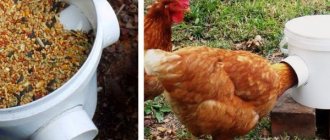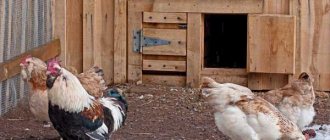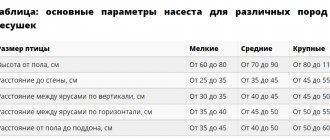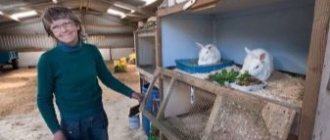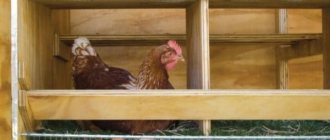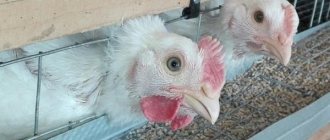05/01/2019 Bender Rodriguez Homemade products
The standard option for dishes for feeding chickens has always been a metal or wooden trough. A feeder of this type is very ineffective and unprofitable, since the chickens constantly turn the container over and scatter the grain. You have to constantly monitor cleanliness. There is an alternative to this device - chicken feeders made from sewer pipes.
The cost of the material is low, it is easy to work with, and the design principle helps to keep the grain from spilling out and raking. Special systems allow you to dispense feed in portions without constantly monitoring the feed level.
Principle and features of the device
An affordable material is suitable for making chicken feeders from sewer pipes. The assembly process of the device takes little time. Since plastic pipes have minimal weight, attaching such structures is quite simple.
Chicken feeders made from sewer pipes are distinguished by their versatility, functionality and long service life. You can make such a device using basic tools. At the same time, the design looks neat and is convenient to use. It can be cleaned, washed, filled with food, and moved without any problems.
Additionally, it is recommended to use additional devices that will help make the feeder more functional. These may be elements used to fasten sewer pipes.
This is interesting
From PVC material you can build not only a container for feeding chickens. Another budget-friendly, simple and convenient option is to assemble a drinking bowl.
Continuing the topic, we recommend that you read the information from the article: “On the types of drinking bowls for chickens.”
If the container is planned to be used as a drinking bowl, it should be taken into account that it must be insulated in cold weather. When the external temperature drops below 0 degrees. Find out more in the article “Do-it-yourself winter waterers for chickens.”
In any case, at low temperatures the entire chicken coop requires insulation. The article “How to insulate a chicken coop for the winter with your own hands” will help here.
Types of structures
Chicken feeders made from sewer pipes can come in a variety of designs. Types of devices:
- Vertical - the body is placed perpendicular to the floor covering.
- Horizontal - the main part of the device is placed along the wall of the chicken coop parallel to the ground.
- Hopper - allows you to regulate the supply of feed for poultry.
Sometimes, according to the principle of placement and manufacturing, a bunker feeder is combined with a vertical or horizontal type. The choice is made taking into account the number of birds, the design of the room or pasture and personal preferences.
Can I buy it in stores?
The choice of feeders in stores starts from the simplest bunkers to high-tech devices with a timer and a feed scattering function.
The price for the simplest bunker feeders is approximately 500-1000 rubles, but for high-tech products you will have to pay 5000-6000 rubles. The body material of the feeders also affects the price . A feeder made of ABS plastic costs 6.5 thousand rubles. Made of powder-coated steel 8.5 thousand rubles.
In stores you can find feeders completely ready for installation and use. They immediately have a food container and a tray.
Better yet, make a feeder yourself from scrap materials . This will cost much less and will correspond to the number of birds.
Read also: Mealybug on ficus benjamina
List of required tools
To make high-quality chicken feeders from plastic sewer pipes, you need to select the appropriate tools and materials. The list will consist of only a few items. This is due to the fact that working with plastic pipes is not complicated by the hardness of the material.
For each type of feeder, pipes with a certain diameter are used. Usually several options are used. Additionally, you may need tees, adapters, and rubber bands to connect elements.
To make holes along the entire length of the pipe, you should use a metal saw or jigsaw. Marking is done using a marker or felt-tip pen. To make the fastening, a drill or screwdriver is useful.
Tightness in some parts of the device can be ensured by applying glue to the seams and cuts with a special gun. But it is better not to resort to using this option, since chickens can peck at the glue.
Where to begin?
In order to make a feeder with cutouts or holes, you will need the following PVC parts and accessories:
- 2 PVC pipes. 60 cm and 80-150 cm with a diameter of 110-150 mm.
- Knee. Accessory connecting pipes at right angles.
- 2 plugs according to the diameter of the pipe.
- Tools.
For a feeder with a tee you should purchase:
3 PVC pipes 10, 20, 80-150 cm with a diameter of 110-150 mm.
- 2 plugs.
- Tee with an angle of 45 degrees for pipes d=110 mm. The tee can be double-sided. Then more chickens can peck at the same time.
- Accessories for attaching the pipe to the wall.
A vertical hopper feeder will require fewer materials:
- 1 pipe up to 150 cm long.
- 1 corner at 45 degrees.
- 1 corner per 90 degrees.
- Stub.
Tools you'll need
- Grinder or hacksaw for cutting pipes.
- Electric drill with wood drill and bit with a diameter of 70 mm.
- Jigsaw.
- File.
- Marker, pencil, long ruler.
Material prices
- PVC pipe D=110 mm – 160 RUR/m.
- Tee D = 11 mm - 245 rub.
- Cap - 55 rub.
- Knee-50 rub.
- Clamps for fastening to the wall for 40-50 rubles.
Making the simplest feeder
If there are no special restrictions or preferences in choosing a device model, then you can choose the most basic one. You can make such a chicken feeder from sewer pipes using the following materials:
Step-by-step instructions for making a feeder:
Operation is very simple. You need to pour grain into a vertical pipe, which will be evenly distributed in the horizontal part with holes.
Product Description
Advantages:
- A plastic pipe feeder is the most reliable of all. It is attached to the wall and the chickens, in the process of feeding and searching for food, cannot turn it over and scatter the grain. Grain is consumed more economically.
- One feeder made of pipes is enough for 20 chickens.
- The longer the pipe, the more feed can be loaded there. Typically, this design can hold up to 10 kg of dry food and there will be no need to run to the chicken coop several times a day.
- Plastic has no limitation on service life. The product is made in a couple of hours and can last for many decades.
- Plastic pipes are very inexpensive and are available at any hardware store.
IMPORTANT : Disadvantages of pipe feeders: the structure is easy to disassemble, but long pipes are difficult to wash under the tap and disinfect inside.
Feeders made from PVC pipes come in: with holes, with cutouts and with a tee . The choice of feed supply device depends on the size of the chicken coop and the location of the cages with the birds.
Option for a bunker feeder made of plastic pipes
This operating principle is considered an ideal option for setting up a chicken coop in which the owners keep many chickens or broilers over two months old. A do-it-yourself bunker feeder for chickens is made as follows:
The operating principle is elementary. Fill the container with grain. The chickens will eat their food, which spills out at the bottom of the feeder. The grain will gradually fall down the pipe. A container with a volume of 6 liters is enough for 30 chickens for one day. You don't have to use the eggplant. Then the grain will be stored in the vertical part of the feeder.
Feeder for chickens - what are the design features
This product has quite a lot of advantages:
- significant service life;
- cheapness;
- ease of manufacture;
- safety for poultry;
- the possibility of producing a model that will suit a specific owner.
Floor feeder made of pipe
In addition, it can be positioned in a way that is convenient for the birds and the owner.
Types of products, what requirements must be met
One of the disadvantages of chickens is that they are messy. They love to dig into the food, actively scatter grain and feed, and then trample it. Some chickens manage to get into the feeder and leave feces there, which contains dangerous bacteria. This could lead to a real epidemic.
To prevent this from happening, you can use wall-mounted feeders. They are screwed using self-tapping screws to the wall at a suitable height - about 25-30 cm. An adult bird can easily get food out of it (of course, a chicken cannot do this, so it is advisable to keep them separately), but it will not be able to climb into it with its feet. This means that feces will not end up in the feeder.
Important! PVC is one of the best materials for feeders, as it is highly durable, easy to clean and resistant to high humidity.
Wall-mounted feeders have a drawback - lack of mobility. Therefore, not all users like them. Then you can choose a regular floor-standing model made of plastic. It can be moved freely throughout the chicken coop, but additional protection must be provided.
Chicken feeder
Making a vertical automatic feeder
This bird feeder design can be made in 10 minutes if you have the necessary materials on hand. It is enough to purchase the base of the product. In this case, the diameter of the PVC pipes should be as large as possible. The cut height should not be more than one meter. Additionally, you need a flat part, for example, a lid from a plastic bucket.
On one side along the edge, cut several small holes, each of which will have the shape of a semicircle. Install such an element into the bucket lid with the exact side down where the holes were formed.
Pour grain into the pipe. It will pour out into the flat lid through the holes. As food is eaten, it will fall down the pipe.
Requirements for hand-made devices
Homemade devices for feeding poultry should be:
- mobile and collapsible so that they can be easily cleaned;
- spacious so that there is enough food for all individuals at once;
- have an approach from all sides to prevent the displacement of weaker individuals, who may ultimately remain hungry;
- have restrictions so that chickens cannot climb and rummage in the feeder;
- have places for feeding at the rate of 10-15 cm in length for each individual (for chickens 5-10 cm).
Non-standard design options
Homemade devices for feeding chickens are more modern, cheaper and functional. Having in your arsenal plastic pipes of different diameters and a saw for cutting, you can make a rather non-standard, but at the same time functional design. Original ideas for chicken feeders:
There are many options for making simple but effective feeders. It’s worth showing your imagination and thinking through the details. Some types of feeders will take no more than 30 minutes to make. You can diversify design options by using several types of materials within one product.
What is a chicken feeding silo system?
Bird feeders can be classified according to several criteria. For example, by type of fastening (suspended, wall, floor); by the type of food for which they are suitable (dry food or wet food), as well as by the method of feeding the food (tray, trough or automatic).
The last type of feeder is considered the most convenient when using bulk feed and is therefore very widely used by poultry farmers. Such devices are called bunkers.
The very idea of a bunker feeder is that only part of the feed in it is in direct access to the birds, while the main supply of dry mixture is located in a closed container. When the tray is emptied to a certain critical volume, the next part of the feed is supplied from a special hopper.
And what is fundamentally important is that this happens automatically, without human intervention.
So, the simplest bunker feeder consists of two main parts - a compartment for food supplies and an open area (tray), from which birds can easily peck the grain mixture. These containers can be connected by a special gutter.
In other designs, food from the bunker enters the open tray by gravity, sagging as the part of the grain accessible to the bird is pecked.
More complex automatic feeders provide for the creation of several bins for different types of dry food: grain mixtures, fine gravel, premixes and mineral supplements.
Did you know? The largest poultry farm in Russia is located in the Tyumen region. The enterprise keeps about four million chickens. More than a billion eggs of thirty different types are sold annually.
Devices may differ in total volume, number of feeding areas, type of fencing (presence of a single tray, restrictive sides, gratings).
Advantages
The advantages of automatic devices over conventional trays and chutes (not to mention feeding grain to birds by scattering it on the floor) are obvious.
- The advantages of such a feed supply system are as follows:
- ensures compliance with sanitary standards in the poultry house, prevents the feeder from turning over and its contents from spilling;
- protects the main part of the feed from contamination and trampling by birds, as a result, the risk of developing infectious diseases (coccidiosis, histomoniasis, trichomoniasis) is reduced, and the cost of purchasing feed is also reduced;
- requires minimal time spent on measuring and pouring dry mixtures (the procedure is carried out no more than once a day instead of three or more times, the volumes of some devices are designed for several days), and therefore can significantly reduce the number of personnel in the poultry house;
- provides poultry with uninterrupted access to clean and fresh food, which is especially important when raising young animals that require more frequent feeding, as well as broilers that eat almost continuously;
- thanks to the constant availability of food, the accumulation of birds around the feeder is eliminated, which saves free space near the tray, which should be allocated to each individual, and also eliminates mutual injury to the inhabitants of the poultry house;
- the device is convenient and easy to use;
- allows you to quickly and effortlessly clean and disinfect all components of the device;
- provides for many modifications, so it can be used for keeping any poultry, regardless of type, size and age.
Did you know? The most voracious bird in the world eats as much food per day as weighs
two-thirds of its body. She lives in the Antilles. It is smaller in size than a sparrow and is called a todi. The chicks of this baby feed about one hundred and forty times during the day.
Flaws
There are few disadvantages to an automatic bird feeding system, but they do exist.
- So, the disadvantages of the design include:
- high cost of some models;
- inability to use for feeding wet food;
- lack of control over the amount of feed eaten by the bird and its excessive availability, which can lead to obesity in the livestock (for this reason, many owners prefer to feed adult birds from ordinary trays or gutters);
- the risk of spoilage of the feed stored in the bunker (if the poultry house is too humid, the grain may become damp and even become moldy, which will have a detrimental effect on the health of the bird);
- increased danger of rodents appearing in the poultry house (pests are attracted by the constant presence of available grain, which chickens do not peck during one feeding, as happens with traditional feeders).
We recommend reading: Snow Leopard. Habitat and lifestyle of the snow leopard. The article will tell you in detail about the snow leopard, where it lives and how the snow leopard is protected.
Formation of a horizontal structure
If the diameter of the sewer plastic pipe is 110 mm, it can become the basis for almost any design option. Additionally, you will need screws, clamps, and tools for cutting plastic. A PVC corner and plugs may come in handy.
The most common option for manufacturing a horizontal feeder can be an autonomous horizontal design. You need to take two pipes. In the first, cut out a part so that you get a kind of “trough”. Close one end of this pipe with a plug. At the second end, fix an elbow to which to connect the second pipe. It should be located perpendicular to the main part (with a “trough”).
Depending on the length of both parts of the pipes, the volume of feed loaded into the main part of the device is calculated. You can make the same option, but for 2 parallel feeders, which will improve the efficiency of the design.
Source: fb.ru
Nipple drinker - how to make it
In addition to feeders, you can build a nipple drinking system for birds from eco-plastic pipes. This design allows you to reduce water consumption and give the pestle exactly as much water as it needs, not a drop more. To do this, you will need a nipple, a drip eliminator, square-section eco-plastic, and a fixative. It is also important to have a plug and adapter.
For adult birds, nipple systems with a rotation of 180° are used, for chickens - 360°. With the closed method of keeping cage batteries, the nipple system can be attached both from the inside and from the outside. A drip eliminator is installed directly under the nipple. It is recommended not to install nipples without drip eliminators, because water will spill directly onto the flooring, which creates a lot of dirt and increases humidity in the coop. The number of such drinkers is set depending on the number of birds at the rate of 1 drinker for 3-4 birds.
Most often, the liquid distributor is a 20-liter bottle. It is connected with flexible tubes. A ball valve is installed at the entrances to the tubes, which regulates the water supply. Water will be supplied to the nipple directly through the tubes, so each valve should be well sealed to avoid leaks. Drip collectors can also be made with your own hands from plastic bottles.
The winter drinker will feature an insulated container into which you can insert the most ordinary medium-power boiler. The water in the drinker will not heat above 10°C in severe frosts, however, this method will protect the liquid from freezing. You can design a similar system, install devices for heating water and equip the structure with a thermostat to regulate the temperature and keep it at a constant level.
READ ALSO: Which polypropylene pipes are better for heating and water supply
